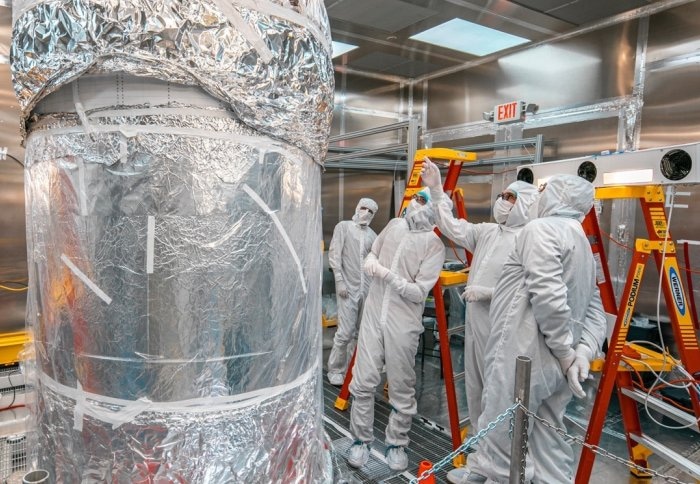Aug 8 2019
The major component of the LUX-ZEPLIN (LZ) xenon detector is ready to be closed and lowered almost 1.5 km underground, where it will look for dark matter.
 Researchers examine the foil-wrapped LUX-ZEPLIN xenon detector. (Image credit: Matt Kapus)
Researchers examine the foil-wrapped LUX-ZEPLIN xenon detector. (Image credit: Matt Kapus)
Dark matter is an enigmatic form of matter believed to constitute about 85% of the mass of the universe. But even today, dark matter has not been detected because it is believed to interact weakly only with normal matter.
LZ will be the most sensitive dark matter experiment ever developed. On July 26th, 2019, scientists finished assembling its centerpiece—the liquid xenon Time Projection Chamber, or TPC,—at the Sanford Underground Research Facility located in South Dakota, USA.
“This xenon detector will be at the heart of the LZ dark matter experiment,” stated Professor Henrique Araújo, from the Department of Physics at Imperial College London, who heads the LZ collaboration efforts in the United Kingdom and co-headed the development of the TPC with Professor Tom Shutt from SLAC National Accelerator Laboratory.
13,500 Hours of Effort
In order to assemble the TPC, 250 members representing 37 institutions from across the world joined hands to make sure that the project’s radiological, electrical, optical, mechanical, and cleanliness requirements were fulfilled.
The development of an unlimited number of components that make up the TPC was initiated in 2015, and instrument assembly was started in December 2018. During the integration phase, 13,500 hours of effort were involved—a major part of which was dedicated to maintain the needed ultra-clean conditions at the surface-level assembly laboratory.
Next, the xenon detector will be embedded into its cryostat vessel—a kind of chamber that sustains cold temperatures—and will be lowered almost 1.5 km underground into a abandoned goldmine, ready to positively identify dark matter. Operations are scheduled to begin in mid-2020.
We have some things in common with a space program. Before you launch, you do all of your work on the ground for years, perfecting the engineering so your instrument will work no matter what. LZ is a bit like a space experiment, just headed the opposite direction. We cannot expose it to underground air – that would compromise its performance. Once you deploy it underground, that's it. It has to work.
Henrique Araújo, Professor, Department of Physics, Imperial College London
Detecting WIMPs
Once the xenon detector is underground, it will be cooled to –100 °C and filled with 10 tons of liquid xenon. Since xenon happens to be a heavy element, there is a higher possibility of xenon atoms communicating with theoretical dark matter particles known as WIMPs—feebly interacting massive particles.
According to researchers, the interaction between a WIMP and a xenon atom will create two flashes of light. One flash appears quickly when collision occurs between the particle and a xenon atom, with the latter recoiling through the liquid. The second flash is produced by electrons shaken off during this collision, which are directed to the top of the detector and expedited through a gaseous xenon layer above the liquid.
While these flashes would not be visible to the human eye, the detector is lined with an unlimited number of photomultiplier tubes. Such ultrasensitive sensors can increase a signal from even one photon of light.
Decades of Development
The TPC design used by the LZ xenon detector has been optimized over years of experimentation with analogous detectors that enable scientists to establish where exactly an interaction takes place, and whether it is probably caused by a true dark matter signal or a background interaction in the instrument.
Among these were the ZEPLIN-III experiment conducted at the Boulby Mine in North Yorkshire, headed by Imperial College London, and the US-led LUX experiment – which resulted in the LZ xenon detector.
Since the experiment is concealed deep underground, it is protected from various background interactions from processes that are instantly identified at the surface. Such interactions can obscure a signal from dark matter, for example, the cosmic rays showering the Earth from outer space.
The TPC is a complex system and it's a major achievement to have it fully assembled. It takes us one important step closer to being able to look for dark matter. It is also gratifying because it involved assembling a large number of subsystems designed and built by groups across the US and the UK over a number of years. So, it’s a coming together of sorts for the collaboration.
Tom Shutt, Professor, SLAC National Accelerator Laboratory
The LZ was mainly supported by the US Department of Energy Office of Science, the South Dakota Science and Technology Authority, the UK’s Science & Technology Facilities Council and by collaborating members in Portugal and South Korea.